AMD Launches Radeon RX 6600: More Mainstream Gaming For $329
by Ryan Smith on October 13, 2021 9:00 AM EST- Posted in
- GPUs
- AMD
- Radeon
- RDNA2
- RX 6000 Series
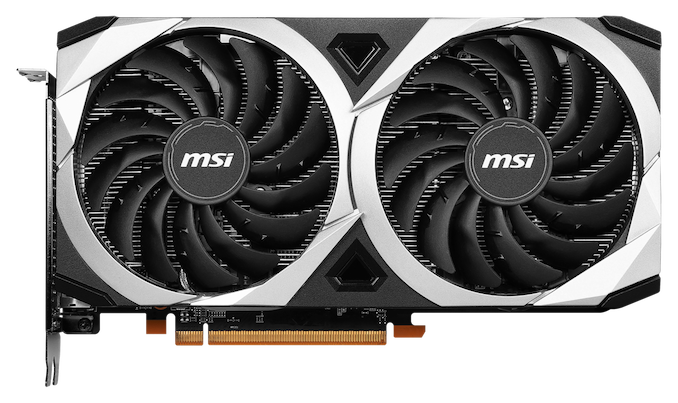
AMD this morning is once again expanding its Radeon RX 6000 family of video cards, this time with the addition of a second, cheaper mainstream offering: the Radeon RX 6600. Being announced and launched this morning, the Radeon RX 6600 is aimed at the mainstream 1080p gaming market, taking its place as a second, cheaper alternative to AMD’s already-released Radeon RX 6600 XT. Based on the same Navi 23 GPU as its sibling, the Radeon RX 6600 comes with 28 CUs’ worth of graphics hardware, 8GB of GDDR6 VRAM, and a 32MB Infinity Cache, with prices starting at $329.
AMD launched the first members of its Radeon RX 6000 family just under a year ago, and even with both the ongoing pandemic and a tumultuous market for video cards, the company has been continuing to roll out additional video cards in a rather straightforward cascading fashion. Now up to their 6th RX 6000 desktop card, AMD is filling out the lower-end of their lineup as market and supply conditions allow. This means that with their first Navi 23-based desktop card having launched back in August – the Radeon RX 6600 XT – the company is now ready to roll out a lower-tier version of the card going after the same 1080p gaming audience.
As is typical for second-tier cards, the Radeon RX 6600 is essentially a cut-down version of the RX 6600 XT. AMD is using the same Navi 23 GPU and GDDR6 memory combination, but everything is dialed down in performance in some fashion, making for a slightly lower performing and cheaper card. Market pricing insanity aside, this is essentially AMD’s more direct answer to NVIDIA’s GeForce RTX 3060 in both projected performance and in MSRPs. The drop in gaming performance from the RX 6600 XT in turn is palpable – this is not an “epic” 1080p card as the RX 6600 XT was – but for gamers who aren’t trying to run games at over 60fps to begin with, the RX 6600 should still prove a capable card.
| AMD Radeon RX Series Specification Comparison | ||||||
| AMD Radeon RX 6600 XT | AMD Radeon RX 6600 | AMD Radeon RX 5600 XT | AMD Radeon RX 5500 XT | |||
| Stream Processors | 2048 (32 CUs) |
1792 (28 CUs) |
2304 (36 CUs) |
1408 (22 CUs) |
||
| ROPs | 64 | 64 | 64 | 32 | ||
| Game Clock | 2359MHz | 2044MHz | 1375MHz | 1717MHz | ||
| Boost Clock | 2589MHz | 2491MHz | 1560MHz | 1845MHz | ||
| Throughput (FP32) | 9.7 TFLOPS | 7.3 TFLOPS | 7.2 TFLOPS | 5.2 TFLOPS | ||
| Memory Clock | 16 Gbps GDDR6 | 14 Gbps GDDR6 | 12 Gbps GDDR6 | 14 Gbps GDDR6 | ||
| Memory Bus Width | 128-bit | 128-bit | 192-bit | 128-bit | ||
| VRAM | 8GB | 8GB | 6GB | 8GB | ||
| Infinity Cache | 32MB | 32MB | N/A | N/A | ||
| Total Board Power | 160W | 132W | 150W | 130W | ||
| Manufacturing Process | TSMC 7nm | TSMC 7nm | TSMC 7nm | TSMC 7nm | ||
| Transistor Count | 11.06B | 11.06B | 10.3B | 6.4B | ||
| Architecture | RDNA2 | RDNA2 | RDNA (1) | RDNA (1) | ||
| GPU | Navi 23 | Navi 23 | Navi 10 | Navi 14 | ||
| Launch Date | 08/11/2021 | 10/13/2021 | 01/21/2020 | 12/12/2019 | ||
| Launch Price | $379 | $329 | $279 | $199 | ||
At the heart of the RX 6600 is a cut-down version of the Navi 23 GPU. We’ve already covered this for both the RX 6600 XT launch and the RX 6600M launch, so I won’t go over it in great detail, but it’s proven a potent GPU, making up for a lack of external memory bandwidth with its 32MB Infinity Cache. The specific version AMD is using here has 28 of the GPU’s 32 CUs enabled, meaning that it’s dropping about 13% of its graphic hardware relative to the RX 6600 XT.
Clockspeeds have also been turned down. While the 2491MHz boost clock is not too far off of the RX 6600 XT’s boost clock, the 2044MHz rated game clock is a more significant reduction, coming in at 13% lower than its faster sibling. The net result is that for shading/texturing/RT performance, on-paper the RX 6600 is set to deliver only around 76% of the XT’s performance. ROP throughput and other aspects fare a bit better since they aren’t part of the cut-down CU count, but that’s still a 13% on-paper drop in throughput as well.
Meanwhile on the memory front, things have been similarly dialed down. AMD’s board partners are still shipping the card with 8GB of GDDR6 attached to a 128-bit memory bus – so there haven’t been any capacity reductions – but AMD is finally getting away from mandating 16Gbps memory across all of its cards. Instead, the Radeon RX 6600 calls for GDDR6 running at 14Gbps, which works out to a total memory bandwidth of 224GB/sec, a 12% drop versus the RX 6600 XT. Overall this move isn’t too surprising, since with fewer CUs to feed, the amount of pressure on the card’s memory bandwidth is reduced. I suspect AMD is also able to get these chips running at lower power levels, which never hurts from an efficiency standpoint. This does mean that the on-die Infinity Cache SRAM is now more important than ever, however, as it has to work all that much harder to hide the limited external memory bandwidth.
Finally, with the reduction in CU counts and overall performance versus the RX 6600 XT, the RX 6600’s Total Board Power (TBP) rating is also lower, with AMD setting the baseline at 132W. Notably, this makes the RX 6600 the first sub-150W desktop video card we’ve seen this generation; the RX 6600 XT was 160W, and the RTX 3060 was 170W TDP. So there is an opportunity for the RX 6600 to fit into a wider array of systems than the XT version did, especially with its 450W PSU recommendation. However, with that said, of the photos and specifications I’ve seen for partner cards thus far, I’ve yet to see a card that comes with a 6-pin PCIe power connector – every card is either indeterminate or comes with an 8-pin connector. So there may be few (if any) cards that are actually suitable to go into systems limited to sub-150W cards.
For people who know their video card/GPU specifications by heart, overall the RX 6600 looks a whole lot like the RX 6600M. AMD’s lowest-tier mobile part was the first Navi 23 product to launch and features a similar 28CU configuration, but with higher clockspeeds and a lower power range. To that end, I suspect that the bulk of the GPUs going into the RX 6600 are chips whose power usage didn’t make the cut for laptops – those leakier, hotter chips that require just a bit more voltage and power to run than what’s suitable for laptop use. Still, expect to see AMD hammering power efficiency in their marketing materials, as the card’s low TBP means that it comes in with a notable advantage.
Product Positioning, Partner Cards, & Availability
As previously mentioned, AMD is aiming the RX 6600 at the mainstream 1080p gaming market. The smaller sibling to the RX 6600 XT, it isn’t able to hit the same high 1080p framerates as AMD’s other 1080p card. Consequently, while AMD sold the RX 6600 XT on being nearly overpowered for 1080p gaming, the RX 6600 vanilla is more of a traditional offering to the 1080p@60fps market.
The principle competition for it, in turn, is NVIDIA’s GeForce RTX 3060. With the RX 6600 XT capable of beating the RTX 3060 much of the time, the RX 6600 is more of a direct competitor. To be sure, this isn’t a fight the RX 6600 is capable of winning – even AMD admits that they expect the card to win some and lose some depending on the game and settings used – so the direct competitor description is accurate. This is further underscored by the $329 price tag, which is the same MSRP as the RTX 3060. In practice, I suspect that AMD's performance aspirations are a bit higher than their hardware can meet, but even if it fails to hold even with the RTX 3060, AMD will have little trouble selling the card in today's market.
Meanwhile, more directly undermining AMD a bit here in the hardware department is memory capacity; NVIDIA famously gave the competing RTX 3060 12GB of VRAM to avoid having just 6GB. So while AMD’s offering is more than sufficient for current games, the RTX 3060 will have some additional legroom in the future. Which is all the more reason AMD marketing is instead focusing on things like energy efficiency.
Moving on, let’s talk about the RX 6600 cards themselves. Like the RX 6600 XT, AMD is leaving card manufacturing entirely up to its board partners, who have developed their own custom designs – many of which are reused from the RX 6600 XT. This, of course, also means that there are no reference AMD cards (outside of the company’s labs, at least).
Given the tight market for video cards right now, expect to see AMD’s board partners pile on features and factory overclocks as value-add features for their cards. If things pan out for the RX 6600 like they did the XT, then we’ll see a couple of basic models, and a lot of premium cards with multiple fans and as much RGB lighting as your computer case can handle. On the flip side, there is at least one ITX card slated to be released as well, so manufactuers are taking advantage of the lower TBP to enable some smaller cards, as well.
Low-power gamers in particular will want to triple-check the specifications of RX 6600 cards before buying anything. While AMD’s reference TBP is low enough to allow for a sub-150W card – 6-pin connector and all – the push for premium means that board partners are going to want to overbuild and overclock their cards. So it’s not clear at the moment just how many card models will actually operate below 150W. We should know more later today once complete retail listings go live.
As for pricing and availability, there’s little that can be said today that wasn’t already said during any other video card launch this year. Demand for video cards still greatly outstrips supply – thanks in large part to cryptocurrency mining (ETH is at $3400 as of the time of this writing) – so initial shipments of cards have been quick to go, and smaller restocks even faster. Furthermore, at a $329 MSRP the RX 6600 is tied for the cheapest card of this generation, so following the usual demand curves, expect it to be a hot commodity.
Similarly, even with the lower performance of the RX 6600 relative to the RX 6600 XT, I don’t expect to see post-launch retail prices for this card stay at $329, or even under $400 for that matter. Where retailer prices settle remains to be seen, but the high demand for RX 6600 XT cards at well over $400 paints a similar picture for the RX 6600. Which is to say that buying cards at launch may be gamers’ best bet of getting a card remotely close to the official MSRP.
Still, as with the Radeon RX 6600 XT launch, even if AMD’s latest card ends up being hard to get, one more line of video cards on the market is one more chance to grab a video card. Until the demand side of the equation comes down, the next best thing video card makers can do is increase supply, and getting a second-tier Nav 23 card out there is one more way to do that.
| Q4 2021 GPU Product Lineups (Theoretical MSRPs, Please See eBay For Street Pricing) |
|||||
| AMD | Price | NVIDIA | |||
| $1499 | GeForce RTX 3090 | ||||
| Radeon RX 6900 XT | $999 | ||||
| Radeon RX 6800 XT | $649/$699 | GeForce RTX 3080 | |||
| Radeon RX 6800 | $579 | ||||
| Radeon RX 6700 XT | $479/$499 | GeForce RTX 3070 | |||
| Radeon RX 6600 XT | $379/$399 | GeForce RTX 3060 Ti | |||
| Radeon RX 6600 | $329 | GeForce RTX 3060 | |||


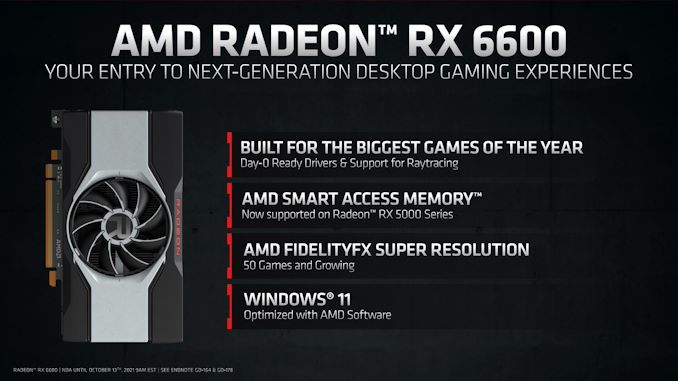
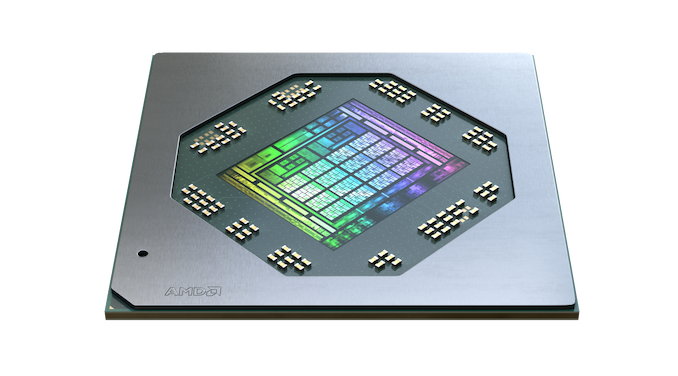
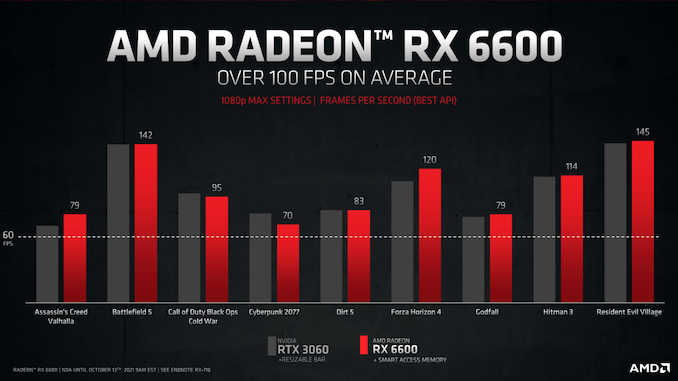
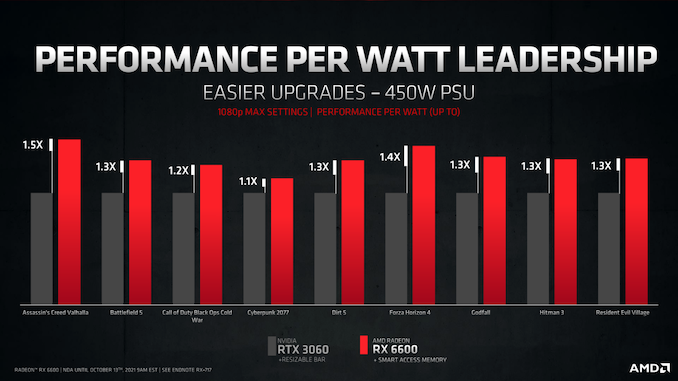
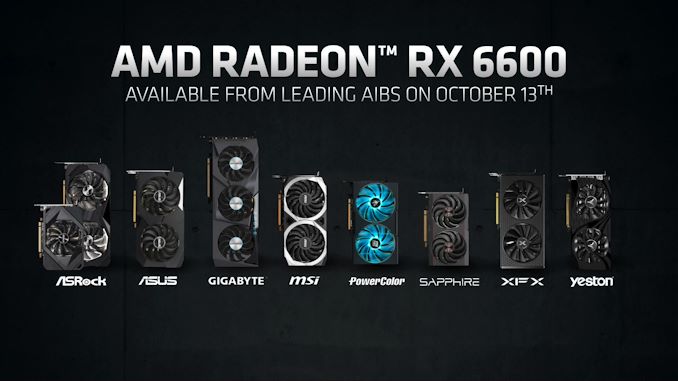














45 Comments
View All Comments
boozed - Wednesday, October 13, 2021 - link
Markets in all industries are experiencing shortages and skyrocketing prices right now. Now I'm not saying correlation equals causation, but I'm also not NOT saying that either.TheinsanegamerN - Thursday, October 14, 2021 - link
You're not going to complain about a 50% price increase?Must be nice being rich.
GreenReaper - Thursday, October 21, 2021 - link
Interesting perspective on "competition" - where do you think the streaming companies get the GPUs to render the games? It's two sides of the same coin.Spunjji - Thursday, October 14, 2021 - link
Why would you be trying to squeeze 4K out of this card?Alistair - Wednesday, October 13, 2021 - link
$600 CAD in Canada, so even the $330 means nothing, it launched at a higher price than the 6600 XT launched at.flyingpants265 - Wednesday, October 13, 2021 - link
Agreed, I'm not sure where they are getting these MSRP numbers anymore.Stuka87 - Wednesday, October 13, 2021 - link
MSRP has never meant Retail price. MSRP is what the manufacturer suggest they cost. Retailers can list them for whatever they want.Makaveli - Wednesday, October 13, 2021 - link
Yup MSRP is always before retailer markup.Calin - Thursday, October 14, 2021 - link
Old people might remember a time when "normal" video cards sold even below MSRP, and at MSRP you had things like more/larger fans, more/larger heat sinks, better power delivery/overclocking potential.Lord of the Bored - Saturday, October 16, 2021 - link
I remember when they didn't even have heatsinks. And fit in one slot on the Very Long Bus.